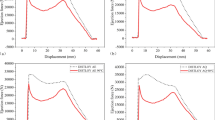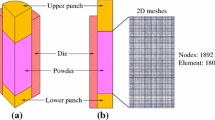Powder compaction is the most crucial process in powder metallurgy since almost all the desired properties of a material, such as a shape, size, density, porosity, hardness, and other mechanical properties, can be controlled during this process. The powder compaction can be performed differently depending on the type of die (single-piece or split), the punch movement, and processing parameters. According to the punch movement, there are two types of compaction, uniaxial or multiaxial. Uniaxial compaction can also be divided into single-action and double-action subtypes. Thus, single-action uniaxial compaction implies that only the upper punch can move, and the lower one remains fixed. When both the upper and lower punches are moving, the process is called a double-action uniaxial compaction. If, at the same time, the powder is compacted from more than one side, then compaction is said to be multiaxial. During isostatic pressing, pressure is exerted on powder in all directions, implying a multiaxial compression. Properties of a powder metallurgy green compact depend on the type (uniaxial or isostatic) and pressure of powder compaction, as well as the type of matrix material and reinforcing agent (metallic, carbonaceous, or ceramic). This work involves a comparative study of different types of powder compaction dies. Also, the compressibility of different matrix materials (i.e., Al6061, Mg, and Cu) and various reinforcing agents (metallic, carbonaceous, and ceramic) was examined experimentally. The analysis of different powder compaction dies revealed that the isostatic pressing ensures uniform densification but is more costly. The compressibility of Al6061 was the greatest, and the compressibility of Cu 10% B4C was the lowest. The addition of metallic and carbonaceous reinforcements enhanced compressibility, while ceramic reinforcing agents contributed to its reduction.






Similar content being viewed by others
References
H. Yu, H. Zhou, Y. Sun, L. Ren, Z. Wan, and L. Hu, “Microstructures and mechanical properties of ultrafine-grained Ti/AZ31 magnesium matrix composite prepared by powder metallurgy,” Adv. Powder Technol., 29, No. 12, 3241–3249 (2018).
N. Kumar, A. Bharti, M. Dixit, and A. Nigam, “Effect of powder metallurgy process and its parameters on the mechanical and electrical properties of copper-based materials: Literature review,” Powder Metall. Met. Ceram., 59, No. 7–8, 401–410 (2020).
Y. Alshammari, M. Jia, F. Yang, and L. Bolzoni, “The effect of α + β forging on the mechanical properties and microstructure of binary titanium alloys produced via a cost-effective powder metallurgy route,” Mater. Sci. Eng. A., 769, 138496 (2020).
F.H. Froes, “Titanium powder metallurgy: A Review – Part 1,” Adv. Mater. Proc., 170, No. 10, 26–29 (2012).
N. Kumar, A. Bharti, and H. Tripathi, “Investigation of microstructural and mechanical properties of magnesium matrix hybrid composite,” in: Advances in Mechanical Engineering, Springer, Singapore (2020), pp. 661–669.
I.C. Sinka, “Modelling Powder Compaction,” KONA, No. 25, 4–22 (2007).
D. Kumar, A. Bharti, S.M. Azam, N. Kumar, and H. Tripathi, “Investigations of mechanical properties of copper matrix hybrid composite,” in: Advances in Mechanical Engineering, Springer, Singapore (2020), pp. 671–676.
A.C.F. Cocks, “Constitutive modelling of powder compaction and sintering,” Prog. Mater. Sci., 46, 201– 229 (2001).
N. Kumar, A. Bharti, and K.K. Saxena, “A re-analysis of effect of various process parameters on the mechanical properties of Mg based MMCs fabricated by powder metallurgy technique,” Mater. Today: Proc., 26, 1953–1959 (2020).
M. Guden, E. Celik, A. Hizal, M. Altindis, and S. Cetiner, “Effects of compaction pressure and particle shape on the porosity and compression mechanical properties of sintered Ti6Al4V powder compacts for hard tissue implantation,” J. Biomed. Mater. Research. Part B: Applied Biomater, 85, No. 2, 547–555 (2008).
H. Jakub, Z. David, J. Lucie, Z. Jiri, and N. Jan, “Effect of particle shape and size on the compressibility and bulk properties of powders in powder metallurgy,” in: Metal, Brno (2016).
W.M. Long, “Radial pressures in powder compaction,” Powder Metall., No. 6, 73–86 (1960).
R.W. Heckel,“Density-pressure relationships in powder compaction, Transactions of the Metallurgical Society of AIME, 221, 671–675 (1961).
C.L. Martina, D. Bouvard, and S. Shima, “Study of particle rearrangement during powder compaction by the Discrete Element Method,” J. Mechan. Phys. Sol., 51, 667–693 (2003).
B.J. Briscoe and S.L. Rough, “The effects of wall friction in powder compaction,” Coll. Surf. A: Physicochem. Eng. Aspects, 137, 103–116 (1998).
L.F. Francis, Materials Processing: A Unified Approach to Processing of Metals, Ceramics and Polymers, Elsevier Inc., Academic Press (2016), pp. 343–414.
Author information
Authors and Affiliations
Corresponding author
Additional information
Published in Poroshkova Metallurgiya, Vol. 60, Nos. 7–8 (540), pp. 24–31, 2021.
Rights and permissions
About this article
Cite this article
Kumar, N., Bharti, A. & Dixit, M. Powder Compaction Dies and Compressibility of Various Materials. Powder Metall Met Ceram 60, 403–409 (2021). https://doi.org/10.1007/s11106-021-00253-x
Received:
Published:
Issue Date:
DOI: https://doi.org/10.1007/s11106-021-00253-x




